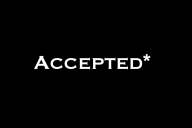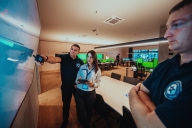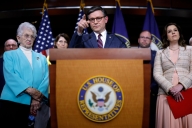You have /5 articles left.
Sign up for a free account or log in.
As public university budgets come under increasing scrutiny, a handful of institutions are giving new meaning to the term "flying coach."
They're actually flying coaches, coaching staffs and sometimes coaches' families around the nation in taxpayer-subsidized airplanes. In other cases, the luxury seats are filled by top university officials on fund-raising trips that, universities say, more than pay for the flights.
Facing the need to cut $20 million from its budget, the University of Kansas is considering a plan to end direct public funding for its jet.
KU’s faculty has long sought the sale of the private Cessna Citation CJ4, a gift to the university and its athletic department.
The university calls the jet “an efficiency tool with a clear return on investment,” but from Kansas to South Carolina to Florida, Indiana and Ohio, the use of university-owned jets and other private aircraft -- often bestowed by wealthy donors -- proves a sore spot between university officials and budget-trimming lawmakers.
The plan to transfer KU’s jet to a “private entity,” first reported by the Lawrence Journal-World, would make it usable only on a fee-for-use basis, without a university subsidy -- much like a privately operated restaurant, university parking garage or apartment building. If KU officials want to use it, they’d need to pay via department funds.
But KU's proposed move could actually make the university's travel arrangements less transparent: when the Associated Press in 2017 asked the University of South Florida to release flight logs, spokeswoman Lara Wade declined, saying the logs didn't have to be released because USF's plane is owned by an outside company.
In an interview, KU Faculty Senate president Kirk McClure said the jet, which was donated to the university and Kansas Athletics Inc., “has been a matter of some difficulty for quite a while,” with taxpayers underwriting flights for university officials, most of them athletic coaches and their families on recruiting “junkets.”
The optics look bad, he said, with legislators publicly asking, “If you’re so damned poor, why do you have this luxurious jet?”
McClure noted that the athletic department, which enjoys gross revenues of $100 million per year, is one of the biggest users of the taxpayer-supported flights. “I don’t think it’s wise for us to be seen in that light,” he said.
Faculty have pushed the university to sell the jet “and get out of the aviation business,” he said, but since KU owns only part of it -- the athletic department owns the rest -- the university can’t sell it outright.
In a statement, KU said staff “make every effort to fly commercial -- and do most of the time. But as a research university with national interests, a Division I athletics program and a mission to serve all corners of Kansas, commercial flight is often inefficient or impossible. In these cases, private aviation is necessary. We monitor this resource closely, and we use it because it is an efficiency tool with a clear return on investment.”
KU said the plane is actually a moneymaker, with its $1.4 million annual public outlay “more than offset” by donations it facilitates. Last year, KU said, donors -- 40 percent of whom live outside Kansas -- gave $155 million. It didn't specify which donations were the result of flights in the Cessna.
The jet also "enhances our ability to partner with federal lawmakers, funding agency administrators and national groups like the Association of American Universities," KU said. "These partnerships are crucial to KU’s efforts to elevate our status as a research university and win research grants," totaling $230 million last year. It also supports KU’s Big 12 Conference membership, which is worth “millions of dollars.”
The university noted that all Big 12 universities -- and many public flagship universities in rural states -- have similar arrangements, either owning planes or chartering flights.
‘Drive -- Like the Rest of Us’
Efficiency tool or not, a private jet provides troublesome optics as universities like KU face tight budgets and are forced to shift a larger burden of costs onto families.
The Lawrence Journal-World, using open-records requests, reported that from 2010 to 2014, taxpayers spent $3.5 million flying coaches, administrators and others on some 641 trips, mostly on university-owned aircraft. The trips’ purpose: to recruit “top-notch professors, athletes, students and researchers,” as well to attend sports and academic meetings, funerals and donor events, both “in Kansas and nationwide.” Flights by KU coaches and athletic administrators accounted for $2.4 million, or about two-thirds of the total sum subsidized by taxpayers, the newspaper reported. The flights were largely for recruitment.
The flights typically cost significantly more than similar flights on commercial aircraft, but KU officials defended them as a smart use of public funds, since they allow more flexibility and efficiency. For example, then KU chancellor Bernadette Gray-Little flew on the KU jet from Lawrence, Kans., to Salina, Kans., in April 2014 for a speaking engagement. The cost: $3,714. The 138-mile drive would have taken just over two hours each way, but then spokesman Tim Caboni told the newspaper it didn’t make sense for the chancellor to be “driving down the turnpike for hours at a time.” He added, “I would imagine some folks would see that as wasteful. Anything that we can do to deploy her time effectively is a good thing.”
Similar questions have played out elsewhere. The AP in 2017 found that at least 20 public universities own or share ownership of planes for official business. Flight logs showed that the aircraft are also used for unrelated and sometimes personal business. AP found, for instance, that Ohio State University football coach Urban Meyer took 11 personal trips with his family in one academic year, including a vacation in Florida, a weekend getaway to Cape Cod and a spring break trip to South Carolina. The university's athletics department, which is financed without tuition revenue or state funds, picked up the total $120,000 tab. (Note: This paragraph has been updated to clarify the nature of the $120,000 payment.)
AP also noted that Purdue University in 2016 sent a plane from Indianapolis to Providence, R.I., to fetch former NFL lineman Matt Light, an alumnus, for an athletics meeting. It flew him back as well, at a total cost of $15,000. A round-trip commercial flight would have cost less than $400.
At Iowa State University in 2016, then president Steven Leath, a pilot who finished his training while at the university, acknowledged that he used a small university-owned Cirrus SR22 for trips that mixed personal and university business. The arrangement came under public scrutiny after he damaged the plane during a hard landing. Leath later repaid Iowa State more than $36,000 for the damage and for the cost of the trips, The (Cedar Rapids) Gazette reported. The university, which bought the plane for $470,000 in 2014, sold it in 2017 for a $20,000 loss.
The Greenville News last June found that the University of South Carolina often counts on a prop-driven Beechcraft to ferry top officials around the region, a practice that costs hundreds of thousands of dollars annually, more than the university would spend on commercial travel or other means for similar trips. The flights are paid for by student tuition and fees.
In one instance, the newspaper found, five university officials took a trip from Columbia, S.C., to Aiken, S.C., that lasted just 12 minutes -- 30 minutes shorter than driving -- but cost taxpayers $400, 11 times the cost of driving. The university said the plane costs $2,033.38 per hour to operate, including the costs of hangar rentals, parking fees, insurance, two pilots' combined $146,720 annual salaries, pilot training and maintenance.
In another instance, President Harris Pastides flew from Columbia to Kingstree, S.C., in February 2018. The 18-minute flight saved Pastides about an hour compared to driving the 80 mile one-way trip, but it cost $610. Driving would have cost just $51, the newspaper estimated.
An Inside Higher Ed analysis of USC flight logs found that university officials relied upon private flights 57 times during a three-month period last summer -- in August alone, the university logged 25 flights.
A USC spokesman has called the Beechcraft “the most efficient use of staff time,” but State Representative Kirkman Finlay, who sits on the panel that funds higher education, told the Greenville News that relying on a private airplane makes it hard for the university to make the case that students should take on debt to attend. Finlay suggested that university leaders “Drive -- like the rest of us.”
A university spokesman didn't respond to requests for comment but has said publicly that the plane pays for itself, since it allows officials to efficiently secure millions in funding.
Larry Evans, who pilots the university's second plane, dedicated solely to athletics-related travel, told the Greenville News, "It's a huge time-saver." Invoking the Columbia-to-Aiken interstate highway, he added, “Look at I-20. It's a mess.”
The second plane is paid for through the athletics budget, not from student tuition or fees.
University guidelines suggest that the student-funded plane is first and foremost a fund-raising tool. South Carolina’s faculty website encourages departments to use the plane “when traveling on official University of South Carolina business.” Their department won’t be charged for flights if they’re in search of research funding, development or other “fund-raising sources.”
Employees conducting university business that isn’t fund-raising, such as research or conference attendance, can also ride along at no cost -- but only if at least three of the eight seats are occupied by those chasing donations. “Additional representatives are strongly preferred,” the guidelines state, “each with a separate major gift or grant-related appointment.”








